Best Technical SEO Guide for 2023 to Improve Search Visibility
There is no shortcut to success and if you are planning for higher traffic, the secret is to perform SEO- on page, off page, and technical SEO. Here in this blog, we will talk about Technical SEO.
Read Further.
Technical SEO: What is it?
Technical SEO refers to optimising a website’s technical aspects to improve its search engine visibility and rankings. This includes addressing technical issues like website speed, mobile-friendliness, site architecture, URL structure, and security protocols.

Source: www.freepik.com
Technical SEO is important because search engines like Google prioritise fast, secure, easy-to-navigate websites. Optimising these technical elements can improve a website’s search engine rankings and attract more organic traffic.
Technical SEO can improve the overall user experience on a website, leading to better engagement and increased conversions.
Why Technical SEO?
Optimising a website for higher search engine visibility is important to attract traffic. Here are some bullet points outlining the importance of technical SEO:
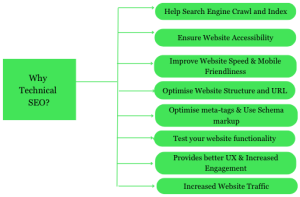
- Helps search engines crawl and index website content more efficiently
- Ensures the website is accessible to users and search engines
- Improves website speed, which is a ranking factor for search engines
- Optimises website architecture and URL structure for better search engine visibility
- Increases website security and protects against hacking and malware
- Helps prevent duplicate content issues with canonicalization and redirects
- Improves mobile friendliness and user experience on different devices
- Provides a better user experience overall, leading to increased engagement and higher search engine rankings
- Helps identify and fix technical issues that may negatively impact SEO, such as broken links or slow page load times
- This can lead to increased website traffic and conversions and improved brand reputation and authority in the industry.
Read: SEO Guidebook.
Checklist for Technical SEO for 2023
Here is a checklist of technical SEO considerations for 2023:
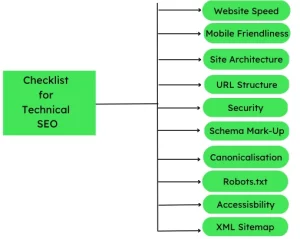
Website Speed:
Ensure your website loads quickly by optimising images, reducing HTTP requests, minimising code, and using a content delivery network (CDN) if necessary.

- Website speed is crucial in technical SEO because it can affect user experience, search engine rankings, and overall website performance.
- The load speed of a website is a significant factor in user experience. A slow-loading website can lead to a high bounce rate and decreased engagement, as users will likely become frustrated and leave the site if they have to wait too long for it to load. In contrast, a fast-loading website can increase engagement, longer session duration, and more conversions.
- Website speed is a ranking factor in search engine algorithms. Search engines like Google prioritise fast-loading websites because they provide a better user experience. Therefore, a website that loads quickly is more likely to rank higher in search results than a slow-loading website.
- Website speed can affect overall website performance. A website that loads slowly can strain server resources and increase hosting costs. It can also affect the website’s ability to handle a large traffic volume, leading to crashes and downtime.
- Optimising website speed can improve user experience, search engine rankings, and overall website performance. Some common ways to optimise website speed include compressing images, minifying code, using a content delivery network (CDN), and reducing HTTP requests.
Mobile Friendliness:
Ensure your website is mobile-friendly and provides a smooth user experience on mobile devices, including responsive design, optimised images, and mobile-friendly navigation.

- Mobile friendliness is essential for user experience. With the increasing use of mobile devices, websites must provide a smooth and responsive experience on smaller screens. A website that isn’t mobile-friendly can be challenging to navigate, read, and interact with, leading to a high bounce rate and decreased engagement.
- Mobile responsive websites are a ranking factor in search engine algorithms. Search engines like Google prioritise mobile-friendly websites in mobile search results because they provide a better user experience. Therefore, a mobile-friendly website is more likely to rank higher in search results than a non-mobile-friendly website.
- Mobile friendliness can affect overall website performance. A website that needs to be mobile-friendly can put a strain on server resources and increase hosting costs. It can also affect the website’s ability to handle a large volume of mobile traffic, leading to crashes and downtime.
- Optimising for mobile friendliness can improve user experience, search engine rankings, and overall website performance. Some common ways to optimise for mobile friendliness include using responsive design, optimising images and videos, and simplifying navigation for mobile users.
Site Architecture:
Create a clear and organised site structure that is easy for users and search engines alike to navigate and understand. Use a logical hierarchy of categories and subcategories, and avoid duplicate content.
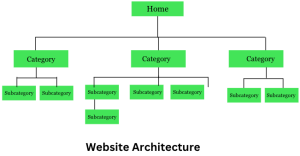
- Site architecture affects user experience by providing a clear and organised structure for users to navigate. A well-structured website makes it easy for users to find the information they seek, leading to increased engagement and conversions. In contrast, a poorly structured website can confuse and frustrate users, leading to a high bounce rate and decreased engagement.
- Site architecture affects search engine visibility by providing a clear and logical hierarchy of pages and content. Search engines like Google use website architecture to understand the context and relevance of each page on a website. Therefore, a clear and organised site structure can help search engines crawl and index your website more efficiently, leading to higher rankings.
- A clean site architecture influences website performance by reducing the amount of duplicate content and broken links on a website. A well-structured web page minimises the number of the same pages and ensures all links work correctly, leading to a better user experience and improved search engine rankings.
- To optimise site architecture for technical SEO, consider using a logical hierarchy of categories and subcategories, creating a clear and concise navigation menu, minimising duplicate content, and ensuring all links work correctly. Optimising site architecture can improve user experience, search engine visibility, and website performance.
URL Structure:
Use descriptive, readable, and SEO-friendly URLs that include relevant keywords and avoid dynamic parameters whenever possible.

- Clean URLs are more accessible for users to read and remember. In addition, a well-structured and descriptive URL can provide users with a clear indication of the content on a page before they even click on it. This can increase click-through rates and reduce bounce rates, as users are likely to click on a URL that accurately reflects the content they seek.
- Clean URLs can improve search engine visibility. Search engines use URLs as a ranking factor, and a clean and descriptive URL can help search engines understand the content and relevance of a page. By using descriptive keywords in URLs, you can help search engines identify the subject matter of a page and improve its chances of ranking for relevant search queries.
- Clean URLs can improve website performance by reducing the number of errors and broken links on a website. A clean URL structure makes it easier to manage and maintain website content, ensuring that all links are working correctly and that there are no broken links or 404 errors.
Security:
Ensure your website is secure using HTTPS protocol, valid SSL certificates, and avoiding mixed content.
- Security is essential for user experience. Secure websites provide users with a safe and trusted environment to browse and interact with. In contrast, websites that are not secure can be vulnerable to attacks such as malware, phishing, and identity theft. This can damage user trust and lead to a high bounce rate and decreased engagement.
- Website security is a ranking factor in search engine algorithms. Search engines like Google prioritise websites that are secure and use HTTPS encryption. By implementing HTTPS encryption and other security measures, you can improve your website’s chances of ranking higher in search results.
- Website security can affect website performance by reducing the risk of downtime and website hacking. A website that is not secure can be vulnerable to hacking attacks, resulting in downtime and data loss. By implementing security measures such as firewalls, malware scanners, and security plugins, you can reduce the risk of downtime and hacking attacks and improve website performance.
Schema Markup:
Implement structured data markup on your website to help search engines better understand and display your content in search results.
Schema markup is a type of code that can be added to a website’s HTML to provide additional information about the content on a page. It helps search engines better understand the content on a webpage and can improve the website’s visibility in search engine results pages (SERPs).

Schema markup can help in technical SEO in several ways:
- Rich snippets: Schema markup can add rich snippets to a webpage’s search result listing. These snippets provide additional information about the content on the page, such as reviews, ratings, pricing, and more. This can help the listing stand out in SERPs and attract more clicks, increasing traffic to the website.
- Knowledge graph: Schema markup can also help a website appear in Google’s knowledge graph. The knowledge graph is a database of information that appears in the search results when users search for specific entities. By adding schema markup to a website, you can help Google better understand the content on the page and increase the chances of it appearing in the knowledge graph.
- A better understanding of content: Schema markup can help search engines better understand the content on a webpage. This can lead to higher search engine rankings and increased visibility in search results. By providing additional context and information about the content, search engines can more accurately determine the relevance of a page to a user’s search query.
Canonicalisation:
Canonicalisation is a technique used in technical SEO to address the issue of duplicate content on a website. It involves identifying the preferred version of a webpage and indicating to search engines which version should be considered the primary version.

Use canonical tags to avoid duplicate content issues and consolidate link equity to the preferred URL version.
- Duplicate content can occur on a website when multiple versions of the same content are available through different URLs. This can cause confusion for search engines and result in a loss of rankings and traffic.
- Canonicalization helps to solve this problem by telling search engines which version of the content should be indexed and displayed in search results. Using a canonical tag, website owners can indicate the preferred URL for a page to search engines, reducing the chances of duplicate content and improving search engine visibility.
- Canonicalization can also help to consolidate link equity. When multiple versions of the same content are available, the link equity can be split between these different versions, resulting in weaker rankings for each performance. By using canonical tags to consolidate link equity, website owners can help to boost the orders of the preferred version of the content.
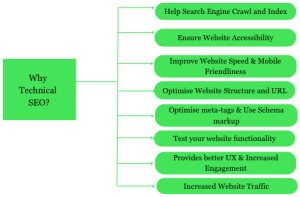
Robots.txt:
Ensure your robots.txt file is correctly configured to allow search engines to crawl your website’s important pages while blocking non-essential pages.
Robots.txt is a file used in technical SEO to control which pages of a website search engine robots are allowed to crawl and index. It is a simple text file placed in a website’s root directory and contains instructions for search engine crawlers.
The robots.txt file helps in technical SEO in several ways:
- Preventing indexing of irrelevant pages: Using robots.txt, website owners can prevent search engines from crawling and indexing pages that are irrelevant to their content or contain duplicate content. This helps ensure that search engines focus on indexing the most important pages on a website, which can improve search engine visibility and rankings.
- Reducing server load: By preventing search engine crawlers from accessing specific pages, website owners can reduce the load on their servers and improve website performance. This can improve the user experience and reduce the risk of downtime or slow loading times.
- Protecting sensitive information: The robots.txt file can also be used to prevent search engines from crawling and indexing pages that contain sensitive information, such as login pages, contact forms, or other private content. This can help to protect user privacy and improve website security.
XML Sitemap:
Create and submit an XML sitemap to help search engines crawl and index your website’s pages more efficiently.

XML sitemaps are important in technical SEO because they provide search engines with a roadmap of all the pages on a website that should be indexed. An XML sitemap is a file that lists all of the pages on a website that a website owner wants search engines to crawl and index. In addition, it provides information about the pages, such as when they were last updated and how important they are in relation to other pages on the website.
There are several reasons why XML sitemaps are important for technical SEO:
- Ensuring all pages are indexed: XML sitemaps help to ensure that all pages on a website are indexed by search engines. Without a sitemap, search engines may miss some pages, particularly those not linked to other pages on the website.
- Faster indexing: XML sitemaps can speed up the indexing process for new or updated pages on a website. By providing search engines with a clear roadmap of all pages on a website, XML sitemaps can help to ensure that new or updated pages are crawled and indexed quickly.
- Better crawling efficiency: XML sitemaps can also help improve crawling efficiency by providing search engines with information about which pages are most important and how they are related. This can help ensure that search engines crawl the most important pages on a website first, improving search engine visibility and rankings.
- Debugging: XML sitemaps can be useful for debugging technical SEO issues. By checking the sitemap, website owners can identify pages that are not being indexed or have errors that need fixing.
Accessibility:
Ensure your website is accessible to users with disabilities by following accessibility standards and guidelines, including alt text for images, descriptive headings, and keyboard navigation.
Accessibility is the practice of designing websites and web content that can be accessed and used by people with disabilities, such as visual or hearing impairments. While accessibility is primarily focused on improving the user experience for people with disabilities, it can also positively impact technical SEO.
Here are some ways in which accessibility can help improve technical SEO:
- Improved website structure: Creating an accessible website often involves improving the website’s structure, such as using proper heading tags, clear and descriptive link text, and logical page layouts. These elements can improve the overall organisation of the website, making it easier for search engine crawlers to understand and index the content.
- Better content optimization: Accessible content is often optimised for readability and clarity, which can also benefit SEO. This includes using descriptive alt text for images, providing transcripts or captions for videos, and ensuring that content is written in plain language that is easy to understand.
- Increased website usability: An accessible website is also often more usable for all users, not just those with disabilities. This can result in longer on-page times, lower bounce rates, and more engaged users, which can signal to search engines that the website is high quality and relevant to the user’s query.
- Improved website reputation: An accessible website is likely to have a better reputation with users and other website owners, which can lead to more inbound links and social shares. These are important factors in search engine rankings and can help improve a website’s visibility in search results.
Brand Example of Technical SEO
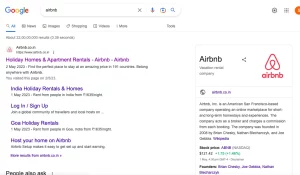
Source: www.google.com
Airbnb is a leading online marketplace for lodging, offering millions of unique accommodations in more than 220 countries and regions. As a large and complex website, Airbnb strongly emphasises technical SEO to ensure their website is accessible and visible to search engines and ultimately drives more traffic and bookings. Here are some examples of technical SEO done by Airbnb:
- Mobile responsiveness: With an increasing number of people accessing the internet on mobile devices, having a mobile-friendly website is critical for SEO. Airbnb’s website is fully responsive, adjusting to different screen sizes and devices, providing a seamless user experience across devices.
- Clean URL structure: Airbnb’s URL structure is clean and straightforward, making it easy for search engines to understand the content of each page. They use descriptive and concise URLs that include relevant keywords and avoid using dynamic parameters or session IDs in the URLs.
- Metadata optimisation: Airbnb has optimised its website’s metadata, including titles and descriptions, for each page to make them more relevant to users and search engines. They use relevant keywords in their metadata and avoid duplicate or empty metadata tags.
- Schema markup: Airbnb uses schema markup to provide additional context for search engines, which can help improve the visibility and ranking of their website. For example, they use schema markup for their events and reviews, which can appear in rich snippets in search results.
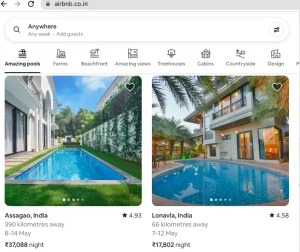
Source: www.airbnb.com
 Source:www.airbnb.com
Source:www.airbnb.com
- Website speed optimisation: Airbnb strongly emphasises website speed optimisation, regularly monitoring and improving the speed of their website. They use various tools and techniques, such as caching, image compression, and minification, to ensure their website loads quickly on all devices.
Things to keep in mind for Technical SEO
Here are 5 critical things to avoid for better technical search engine optimization in 2023:
- Keyword stuffing: Overusing keywords in your content or meta tags can result in penalization from search engines. Focus on providing valuable content that naturally incorporates relevant keywords instead of forcing them into your content.
- Ignoring mobile optimization: With more users browsing the internet on their mobile devices, it’s essential to have a mobile-responsive website. Ignoring mobile optimization can lead to a poor user experience and lower search engine rankings.
- Neglecting site speed: Slow page load times can lead to high bounce rates and negatively impact search engine rankings. Optimise your website’s speed by compressing images, minimising page size, and utilising caching techniques.
- Overusing Flash or JavaScript: Flash and JavaScript can negatively impact site speed and accessibility, making it difficult for search engines to crawl your website. Avoid overusing these technologies, and opt for HTML and CSS instead.
- Forgetting about accessibility: Ensuring that your website is accessible to users with disabilities is ethical and can improve your search engine rankings. Neglecting accessibility can result in legal consequences and negatively impact your brand image.
Conclusion
Technical SEO may not be as difficult as it may seem, but disregarding its importance can negatively impact your search engine rankings. Therefore, if you’re seeking to boost your website’s sales through increased search traffic, it’s crucial to identify gaps in your technical SEO strategy and assess your site’s performance on Google search results. This is where a comprehensive SEO guide like the one you’re currently reading can prove invaluable, saving you time and money as you optimise your site’s search traffic. Connect with us for more insights on technical SEO.
FAQ
What is Technical SEO?
Technical SEO refers to optimising a website’s technical elements to improve its search engine visibility and overall performance. It involves optimising website speed, mobile-friendliness, and structure and ensuring search engines can crawl and index your content effectively.
Why is Website Speed Important for SEO?
Website speed is crucial for SEO because search engines like Google prioritise user experience. Slow-loading websites can lead to higher bounce rates and lower user engagement, negatively impacting your search rankings. Faster-loading pages rank higher in search results and provide a better user experience.
What is XML Sitemap, and How Does It Help SEO?
An XML sitemap is a file that lists all the essential pages of a website and their relationships. It helps search engines understand the structure of your website and discover content more efficiently. XML sitemaps don’t directly improve rankings, but they can ensure that search engines index all your pages, which is essential for SEO.
How Can I Make My Website Mobile-Friendly for SEO?
To make your website mobile-friendly for SEO, you should implement responsive web design, which ensures that your site adapts to various screen sizes and devices.
Optimise images and videos for mobile, use mobile-friendly fonts and buttons, and eliminate any pop-ups or interstitials that could disrupt the mobile user experience. Google’s mobile-first indexing also means that your mobile version is the primary one considered for ranking, so it’s crucial to get this right.



